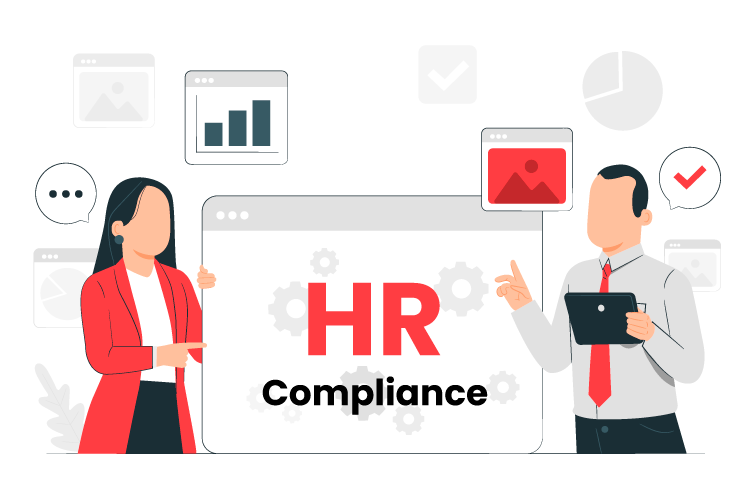HR guide
Chapter 11
HR compliance
HR compliance refers to the legal and regulatory requirements that organizations must adhere to regarding their workforce. The laws and regulations related to HR compliance cover areas such as employee health and safety, fair employment practices, and data privacy. In this chapter, we will explore the importance of HR compliance, legal and regulatory frameworks, key components, challenges, and best practices for ensuring compliance.

Introduction to HR compliance
HR compliance refers to the legal and regulatory requirements that organizations must adhere to regarding their workforce. These regulations are put in place to ensure that organizations operate in a manner that is ethical, fair, and in compliance with local and national laws. HR compliance covers a wide range of areas, including employee health and safety, fair employment practices, and data privacy. Failure to comply with HR regulations can result in legal and financial penalties, damage to an organization’s reputation, and loss of employee trust. Therefore, it is critical for organizations to prioritize HR compliance to protect their employees, their business, and their reputation.
Importance of HR compliance
HR compliance is crucial for organizations as it helps to ensure that they are operating in a legal, ethical, and responsible manner when it comes to their workforce. Compliance with HR regulations helps to protect the rights of employees, prevent discrimination, and promote fair employment practices. It also helps to protect the organization from legal and financial penalties, which can result from non-compliance. Adherence to HR compliance can also enhance the reputation of the organization and foster a positive work culture where employees feel safe, respected, and valued. Finally, HR compliance promotes a healthy and productive work environment, which can contribute to the overall success of the organization.
Key components of HR compliance
The key components of HR compliance include the following:
Recruitment and hiring: Compliance with HR regulations in this area requires organizations to create fair and consistent hiring practices that do not discriminate based on protected characteristics.
Employee classification: Organizations must ensure that their employees are correctly classified as either exempt or non-exempt, and that they are paying them in compliance with wage and hour laws.
Employee records: Organizations must maintain accurate and up-to-date employee records, including employment contracts, payroll information, and employee files.
Health and safety: Organizations must provide a safe and healthy work environment for their employees, comply with health and safety regulations, and provide training to employees on health and safety practices.
Data privacy: Organizations must comply with data privacy laws, including regulations related to the collection, storage, and use of employee data.
Termination and layoffs: Organizations must comply with regulations related to termination and layoffs, including providing notice and complying with regulations related to severance pay and unemployment benefits.
Diversity and inclusion: Organizations must promote diversity and inclusion in their workforce and ensure that their HR practices are inclusive and non-discriminatory.

Challenges in ensuring HR compliance
Ensuring HR compliance can be a challenging task for organizations due to several factors, including:
Changing regulations: HR compliance regulations are continually evolving, and organizations need to stay up-to-date on the latest changes to ensure compliance. Keeping track of these changes can be time-consuming and resource-intensive.
Lack of resources: Many organizations may not have the necessary resources, such as staffing, technology, or expertise, to ensure compliance effectively.
Complexity: HR compliance can be complex and requires specialized knowledge and skills. It can be challenging to navigate the nuances of compliance regulations and ensure that all HR practices are in line with legal requirements.
Non-compliant employees: Even with comprehensive HR policies and procedures in place, employees may fail to comply with them, leading to potential compliance violations.
Global compliance: As organizations expand globally, compliance with HR regulations in different countries can be challenging, with varying laws and regulations that must be followed.
Lack of monitoring and reporting: Organizations must have systems in place to monitor and report HR compliance violations. However, without adequate monitoring and reporting systems, it can be challenging to identify and address compliance violations.
HR compliance checklist: key areas to focus on
Here are some key areas to focus on when creating an HR compliance checklist:
Employment law compliance: Ensure compliance with federal, state, and local employment laws, including equal employment opportunity (EEO) laws, wage and hour laws, and anti-discrimination laws.
Recruiting and hiring: Ensure compliance with hiring regulations, including proper job postings, job descriptions, and pre-employment screenings.
Onboarding and offboarding: Ensure compliance with regulations related to employee onboarding and offboarding, including I-9 verification, background checks, and termination procedures.
Employee classification: Ensure compliance with employee classification regulations, including exempt and non-exempt employee classifications, independent contractors, and interns.
Employee benefits: Ensure compliance with employee benefits regulations, including healthcare coverage, retirement benefits, and time-off policies.
Workplace safety: Ensure compliance with workplace safety regulations, including the Occupational Safety and Health Act (OSHA) and worker’s compensation regulations.
Recordkeeping: Ensure proper recordkeeping practices for employee files, benefits administration, and compliance documentation.
Performance management: Ensure compliance with performance management regulations, including providing regular feedback, conducting performance evaluations, and addressing employee complaints.
HR compliance audits: what you need to know
HR compliance audits are an important part of ensuring that an organization is in compliance with all applicable regulations and laws. Here are some things to know about HR compliance audits:
Purpose: The purpose of an HR compliance audit is to review an organization’s HR policies, practices, and procedures to ensure that they are in compliance with all applicable regulations and laws. The audit helps identify any areas of noncompliance and recommends actions to address them.
Scope: An HR compliance audit can cover a wide range of HR-related areas, including recruitment, hiring, onboarding, employee classification, benefits administration, workplace safety, recordkeeping, and performance management.
Process: The process of an HR compliance audit typically involves a review of HR policies, practices, and procedures, as well as interviews with HR staff, managers, and employees. The audit report typically includes findings of noncompliance, recommendations for corrective actions, and a timeline for implementation.
Benefits: Conducting an HR compliance audit can help organizations identify and address potential compliance issues before they become costly violations. It also helps promote a culture of compliance within the organization and ensures that HR policies and procedures are aligned with business objectives.
Outsourcing: Some organizations may choose to outsource their HR compliance audits to third-party auditors or consultants who specialize in HR compliance. This can provide an objective perspective and may also provide access to specialized knowledge and expertise.

HR compliance management software: benefits and features
HR compliance management software is designed to help organizations manage their compliance-related activities more effectively. Here are some of the benefits and features of HR compliance management software:
Centralized database: HR compliance management software provides a centralized database to store all compliance-related information, including policies, procedures, forms, and training materials. This helps ensure that all information is up-to-date and easily accessible.
Automated compliance tracking: HR compliance management software automates the tracking of compliance-related activities, such as training completion, policy acknowledgments, and license renewals. This helps ensure that employees are in compliance with all applicable regulations and laws.
Customizable workflows: HR compliance management software allows organizations to customize workflows to meet their specific needs. This can include automated notifications, task assignments, and approval workflows.
Reporting and analytics: HR compliance management software provides robust reporting and analytics capabilities, allowing organizations to track compliance-related metrics and identify areas of potential risk.
Integration with other systems: HR compliance management software can be integrated with other systems, such as HRIS and payroll systems, to ensure that compliance-related data is synchronized across all systems.
Scalability: HR compliance management software is scalable and can be customized to meet the needs of organizations of all sizes. This makes it an ideal solution for small businesses as well as large enterprises.
Security: HR compliance management software provides robust security features, including role-based access control and data encryption, to ensure that compliance-related data is secure and protected from unauthorized access.
Best practices for HR compliance
HR compliance is an essential aspect of any organization, and there are several best practices that organizations can follow to ensure they are meeting their compliance obligations. Here are some best practices for HR compliance:
Keep up-to-date with laws and regulations: It’s crucial to stay up-to-date with laws and regulations that affect your organization. HR professionals should be aware of any changes to laws and regulations, and they should ensure that their policies and practices are in line with these changes.
Develop clear policies and procedures: Organizations should develop clear policies and procedures that are in line with the relevant laws and regulations. These policies and procedures should be communicated to employees and reviewed regularly to ensure they remain up-to-date.
Conduct regular training and education: Regular training and education can help ensure that employees understand the laws and regulations that affect their work and are aware of their obligations. HR professionals should provide regular training and education to employees and ensure that they understand the importance of compliance.
Implement an effective compliance program: An effective compliance program should include regular risk assessments, monitoring, and auditing of compliance-related activities. It should also include a reporting mechanism for employees to report compliance concerns or violations.
Use technology to streamline compliance activities: HR professionals can use technology, such as compliance management software, to streamline compliance-related activities. This can include automating compliance tracking, reporting, and record-keeping.
Foster a culture of compliance: HR professionals should foster a culture of compliance within their organization. This can include emphasizing the importance of compliance, recognizing employees who demonstrate good compliance practices, and addressing any compliance issues promptly and effectively.

